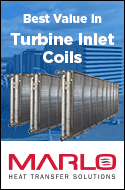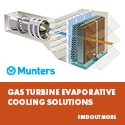Technology Overview
TECHNOLOGIES
Many technologies are commercially available for TIC. These technologies can be divided into the following major categories/groups:- Evaporative:
wetted media, fogging, and wet compression
- Chillers:
mechanical and absorption chillers without or with thermal energy storage
(TES)
- LNG
Vaporization
- Hybrid
Systems: combinations of several technologies
All of the technologies listed above have inherent advantages and limitations. Many published articles are available on these technologies. A number of these publications are listed in the Library
section.
Wetted media is one of the evaporative cooling technologies in which cooling is achieved by evaporation of the water added to the CT inlet air. Historically, it is the first technology to be used for TIC. In this technology, the inlet air is exposed to a film of water in one of the many types of wetted media. A honey-comb-like medium is one of the most commonly employed media. Wetted media can cool the inlet air from the ambient dry-bulb temperature by 85% to 95% of the difference between the ambient dry-bulb and wet-bulb temperature. It is one of the lowest capital and operating cost options. The extent of cooling is limited by the wet-bulb temperature. It works most efficiently during hot and dry weather and is less effective when ambient humidity is high. On an overall basis, this is the most widely used technology.
Fogging is another evaporative cooling technology. The basic idea in this technology is to add water to the inlet air by spraying very fine droplets of water. Fogging systems can be designed to produce droplets of variable sizes, depending on the desired evaporation time and ambient conditions. The water droplet size is generally less than 40 microns and on an average it is about 20 microns. The water used for fogging typically requires demineralization. Fogging systems can cool the inlet air by 95% to 99% of the difference between ambient dry-bulb and wet-bulb temperature. Its capital cost is very comparable to that for the wetted media. It is the second most frequently applied technology for TIC.
Wet Compression
is yet another evaporative cooling technology in which more fog is added
to the inlet air than can be evaporated under the conditions of the ambient
air. The air stream carries the excess fog into the compressor section of
the CT where it further evaporates, cools the compressed air and creates
extra mass for boosting the CT output beyond that possible with the evaporative
cooling technologies. The cooling of the compressor section reduces work
in the compressor section, allowing increased power available from the system.
Wet compression also leads to additional power augmentation due to the increased
mass flow of the water and fuel in the system in order to maintain constant
firing temperature. Wet compression is a complementary technology and can
provide added benefit to any other TIC technology.
Mechanical
Chiller systems cancool the inlet air to lower than wet bulb temperature and when properly designed can maintain any desired inlet air temperature down to as low as 42oF, independent of ambient wet-bulb temperature. The mechanical chillers used in these systems could be driven by electric motors, steam turbines or engines. Drawing the inlet air across cooling coils, in which either chilled fluid or refrigerant is circulated, cools it to the desired temperature. Mechanical chiller-based TIC systems are more capital intensive than evaporative systems and when using electric motors, these systems also have the highest parasitic loads. The chilled water can be supplied directly from a chiller or from a TES (Thermal Energy Storage) tank that stores ice, or chilled fluid. A TES system is typically used when there are only a limited number of hours per day when inlet air cooling is needed. TES can reduce overall capital costs because it reduces the chiller capacity requirements as compared to the capacity required to match the instantaneous on peak demand for cooling. Since the chillers in TES systems are operated during the off-peak period using low-cost electricity for charging the TES tank, such a system increases the net power capacity during the on-peak period.
Absorption
Cooling systems are similar to the mechanical refrigeration systems except that instead of using mechanical chillers, these systems use absorption chillers that require thermal energy (steam or hot water) as the primary source of energy and require much less electric energy than the mechanical chillers. Absorption cooling systems can be used to cool the inlet air to about 50oF. These systems can be employed with or without chilled water TES systems. Absorption chillers can be single-effect or double-effect chillers. The single-effect absorption chillers use hot water or 15-psig steam (18 lb./RT-hr) while the double-effect chillers require less steam (10 lb./RT-hr) but need the steam at higher pressure (115 psig). Compared to mechanical chillers, absorption cooling systems have lower parasitic loads but higher capital costs. The primary successful applications of Absorption chillers in power plants are where excess thermal energy is available and the conversion of this energy to high-value electric energy creates a winning situation for the user.
LNG Vaporization systems are useful for power plants located near a liquefied natural gas (LNG) import or storage facility. In supplying natural gas for power plant or other applications, LNG must be vaporized by some heat source. For applications in TIC, the inlet air is used as such a heat source.
Hybrid Systems incorporate some combination of two or more technologies, such as mechanical and absorption chillers, evaporative and chilling, and fogging or chilling with wet compression. The objective of hybrid systems is to maximize net power output during hot weather. Each hybrid system needs to be optimized for a specific plant based on the weather data, power demand and electric prices and availability of thermal energy.




